A guitar is one of the most versatile instruments in western music. You can play a variety of genres of music using a single guitar. It also familiarizes you with other types of string instruments and though you may not become an excellent mandolin player simply because you know how to play the guitar, the fundamentals have been put in place.
You have become familiar with the notes, strings, and chords when you learn to play the guitar. Transitioning to a ukelele or a mandolin should not be very difficult if you already know how to play the guitar. What’s more, if you have a singing voice and also know how to play the guitar, that is all you need to get started on a musical or stage career. It is an instrument that can be a good accompaniment for any type of music.
Interested in Bass Guitars? Check out our Bass Guitars for Beginners Guide.
The following is a brief guide to different types of guitars and what makes each of them such a special instrument:
What Are the Different Types of Guitar Amplifiers?
When it comes to guitars, acoustic and electric guitars are the most commonly identified categories of guitars. Both guitars are equally versatile and are played in a wide variety of musical compositions. They can be used in, more or less, any piece of composition, regardless of the genre.
Some genres rely more heavily on acoustic guitars (like flamenco, folk, etc.), while others may rely more heavily on electric guitars (like metal, modern rock, etc).
The following are some of the factors on the basis of which acoustic guitars and electric guitars will be compared.
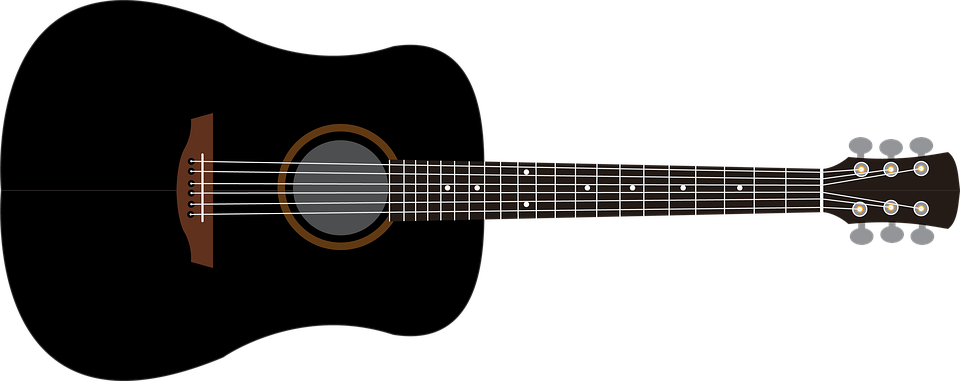
Sound
Both the instruments emit very different sounds. While the acoustic guitar has some softer qualities in its tone, the electric guitar offers a more powerful bass. The following are some of the sound qualities specific to each of the guitars:
- An acoustic guitar offers a great sound when a softer melody is finger picked. It is great for ballads.
- An acoustic guitar has a sound of its own and does not need to be plugged into an amplifier.
- The sound of an electric guitar is limited to and by the tuning — you cannot add too many effects to the tonal quality.
- An electric guitar has a deeper bass sound.
- Electric guitars require an external amplifier to be played.
- Most amplifiers have a clean and a distortion channel so you get more tone options than an acoustic guitar.
Construction
The main difference in construction in an acoustic guitar and an electric guitar is the use of an amplifier in the latter. An electric guitar does not have much of a sound of its own. It needs to be connected to an amplifier, hence, explaining the use of the term “electric” in the name.
Apart from that, the placement of the sound holes also tends to differ in the case of both the guitars, though this rule is not set in stone. In an acoustic guitar, you will generally see a round sound hole in the center of the guitar. This is the most common sight in a traditional classical and Western guitar. These are called flat top guitars. There are also the ‘F’ sound holes that are common in the archtop guitars.
Meanwhile, an electric guitar relies on an amplifier to deliver its sound. What the soundhole does in an acoustic guitar, an amplifier does better in an electric guitar. Sound holes are, therefore, not as crucial for electric guitars as they are for acoustic guitars. But you will often see electric guitars with ‘F’ or ‘C’ holes.
Ease of Use
An acoustic guitar is certainly easier to use as even a beginner can pick up the guitar and start testing their skills. It does not require an amplifier and has its own sound. There are very few things that are needed to set up an acoustic guitar. It can simply be picked up and can be carried around with a lot more ease than an electric guitar.
In the case of an electric guitar, you need to know how to navigate the amplifier. The amplifier can distort the sound and allow you to add various effects. For someone who is completely new to the instrument, the amplifier can be a little daunting to get around. It also limits where one can play the guitar as you would have to carry the amp around wherever you go in order to play even recreationally.
Price
There is no one thing that can be said about the difference in price. Both acoustic and electric guitars are available in a wide variety of price ranges. You can get any of the two guitars for $200 or even for more.
However, an acoustic guitar may be the more budget-friendly option in the long run because the maintenance is a lot easier and economical.
You do not need an amplifier for an acoustic guitar. The only thing you do require to maintain the kit is a good guitar case and spare strings. But even if you manage to buy a moderately priced electric guitar, you would need to spend more money on an amplifier and the contraptions that come with it.
What Are the Different Parts of a Guitar?
Whether you are looking at an electric guitar or an acoustic guitar, the parts of a guitar are not so different. The fundamentals remain the same in both the guitars but the acoustics and sound change based on modifications in the design. The following are some of the most crucial parts of a guitar. These parts are common to both acoustic and electric guitars.
Body
The body of the guitar is made of wood. The different types of wood that go into making the guitar are called the guitar’s tonewood. Some guitars may have a rosewood body and a maple neck. Some of the common types of wood that are used for making a guitar include:
- Indian rosewood
- Cypress
- Mahogany
- Maple
- Arder
The shape of the body differs depending on the type of guitar it is. A classical guitar may have a smaller body while a guitar for a more acoustic or a folk sound may have a larger body.
An electric guitar certainly has a larger and heavier body as that would mean the bass is deeper. Some people assume that the tonewood in an electric guitar does not matter as the instrument relies on electronics for its sound. But this is categorically untrue. The tonewood has a deep impact on the kind of sound the guitar emits. It only relies on electronics to amplify that sound but the foundation of the tonal quality is set by the tonewood of the guitar.
Sound Hole
The sound hole is most prominently seen in an acoustic guitar, though electric guitars also have sound holes. It is an opening in the instrument, usually round or oval in shape, though there are sound holes in other shapes as well. A soundhole helps enhance the acoustics of stringed instruments, especially one that is not attached to an amplifier. The sound essentially emanates from the surface area of the sounding board. The sound hole is able to provide an opening into the resonant chamber inside the guitar’s body, allowing the sounding board to vibrate with greater ease.
The following are common shapes of sound holes in guitars:
- Round/Oval: You will typically see this in a classical or Western acoustic guitar.
- F-Holes: These soundholes are typically found in archtop acoustic guitars and electric guitars. They are shaped like an ‘f’.
- D-Holes: These soundholes are in a blunt ‘D’ shape and are seen in old-fashioned string instruments, like lyras.
- C-Holes: These soundholes are shaped like a ‘C’ and are commonly seen in violas and similar string instruments.

Neck
The neck of the guitar is one of the most crucial aspects of a guitar. You play the chords on the guitar by pressing your fingers down on the appropriate portions of the neck. The neck is what accommodates the frets (more on that later). If you are right-handed, your left hand will be on the neck of the guitar and vice-versa. Guitars are designed differently for left-handed players.
The neck sometimes has a ‘U’ or a ‘V’ shape so that your hands can reach the higher frets with more ease.
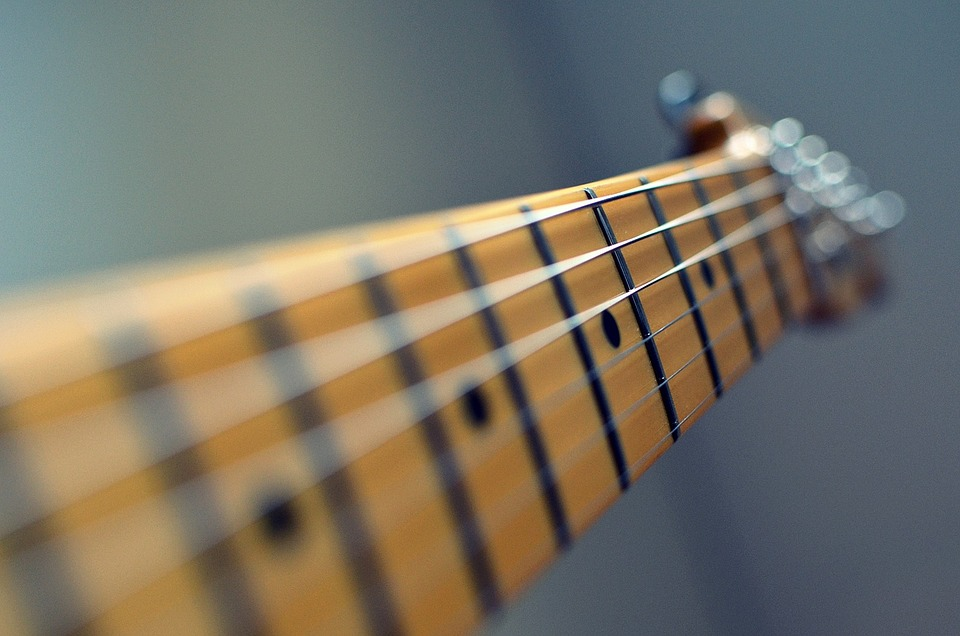
Frets
The frets are markings on the neck of the guitar which indicates where you need to press down on the string in order to get different notes from the same string. Not all guitars have frets. Some guitarists prefer a guitar without frets — especially jazz guitarists — as it helps experiment more with the tones. A violin, for instance, is an example of a stringed instrument without frets. But most guitars do come with the customary fretboard.
Headstock
The headstock is the head of the guitar. This is where the tuners and tuning nuts are placed. This is also where you will see the name of the guitar engraved. The headstock is, in some ways, the nucleus of the guitar. It is where the strings are attached and can be adjusted, giving the guitar the tuning it requires to be played.
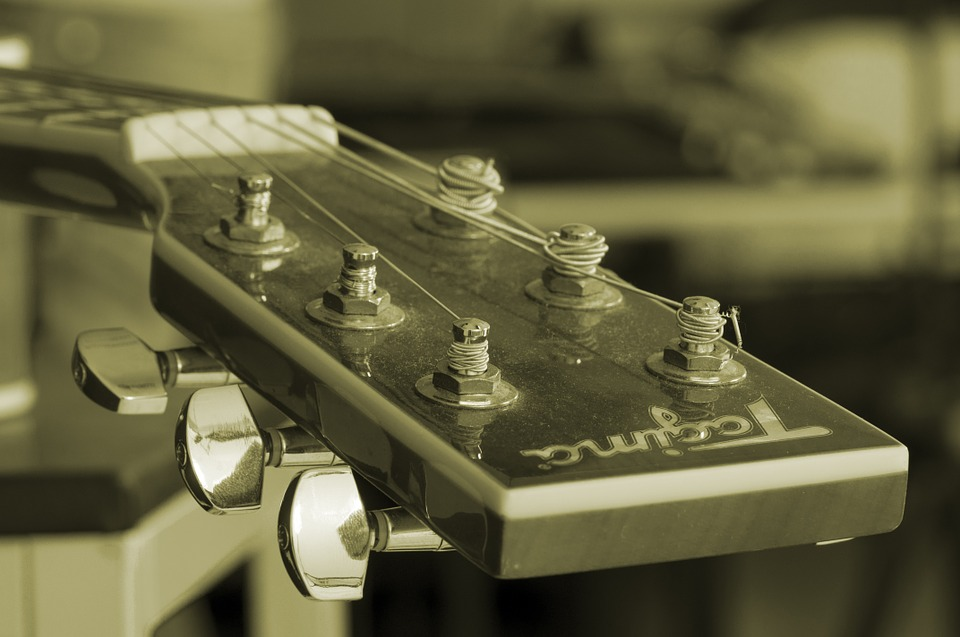
Bridge
The bridge is the other end of the headstock. The strings are attached to the headstock at the top of the guitar and to the bridge at the bottom of your guitar. It is important to check on both sides of the guitar to ensure the tension from tuning the strings is not too high, or else the string might break and the guitar may experience some damage too.
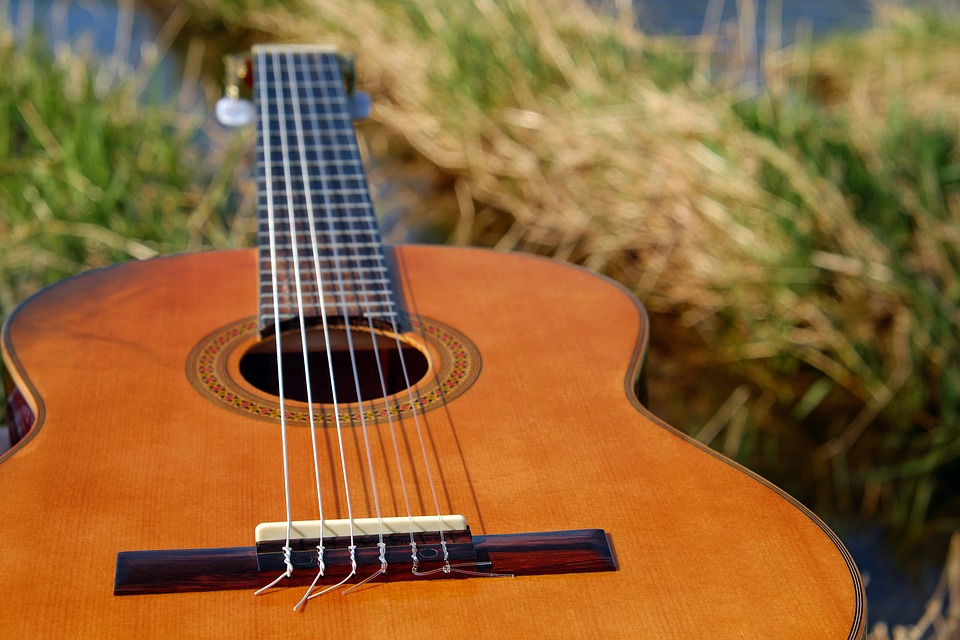
Tuners
The tuners are what the strings are attached to at the headstock. The tuner can be turned around making the string either tauter or more relaxed, depending on how you want to set the tuning. The most common material used for tuners and tuning nuts is metal. The headstock and the tuning nuts are the most vulnerable and crucial elements of a guitar’s body.
Types of Amps
The following are the types of amps that can be used with a guitar.
Combo vs Head
A combo amp is one that has the amplifier and the speakers (one or more) in a single cabinet. This is one of the common configurations for a guitar amplifier. The other common type is known as the head or amp head, where the amplifier is housed separately. The standalone amplifier passes the amplified signal through a cable to the external speakers.
Tube vs Solid State
Tube or vacuum tubes were the most popular type of amp used at least until the 1970s. This type of amp has multiple vacuum tubes that are able to amplify the signal. Some schools of guitarists are of the perception that a tube amp provides a warmer sound even though the technology and circuitry are more or less outdated now.

Solid-state amps are what came after and seem to be more popular at the moment. These guitar amps use solid-state electronics instead of tubes so diodes, transistors, etc., become important to amplify the signal. These amps are cheaper to produce and also cheaper to maintain.
Hybrid
A hybrid amplifier is one that has a combination of tube and solid-state pre-state amplification. It may either have a tube power amp along with a solid-state preamp circuit. Examples of these are the MusicMan amplifiers.
Another type of hybrid amplifier is one with a tube preamplifier along with a solid-state output stage. Examples of these are the Vox amplifiers.
Final Thoughts
The guide on guitars above provides you with some insight into how guitars work and some common facts about acoustic and electric guitars.
It is really easy to identify a guitar when one looks at it but what does each individual part do? These are questions important questions as without knowing how each part of a guitar is significant, you will not understand how the sound gets the tonal quality that it does.
Knowing these small details about guitars will also help you to make a more informed and confident choice if you are out in the market looking for the best guitar to buy.




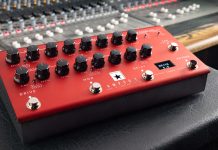

![4 Best Electric Pianos Under $500 [Reviews & Buyer’s Guide] Best electric pianos under $500](https://homestudiohub.com/wp-content/uploads/2020/03/null-8-80x60.png)






